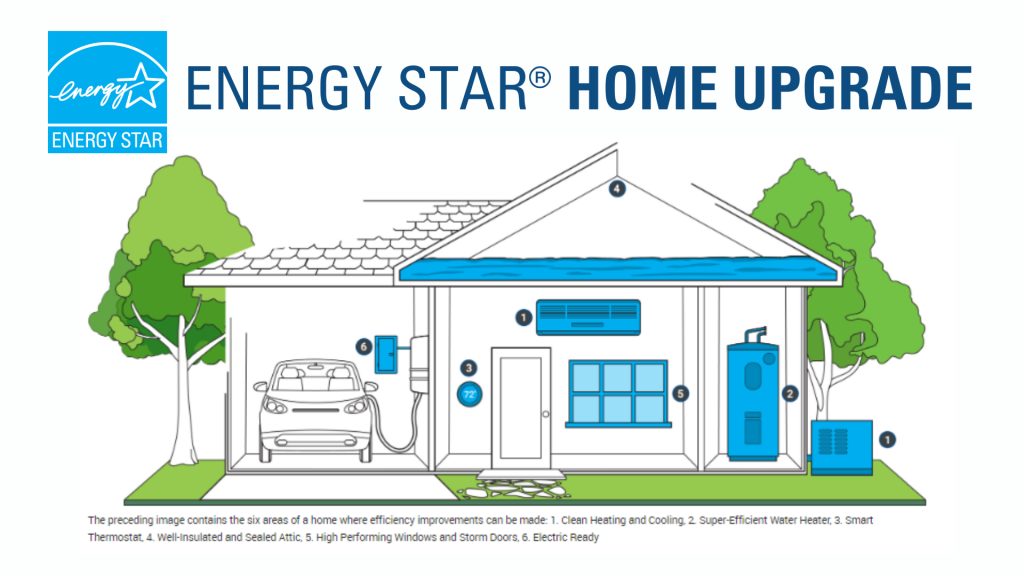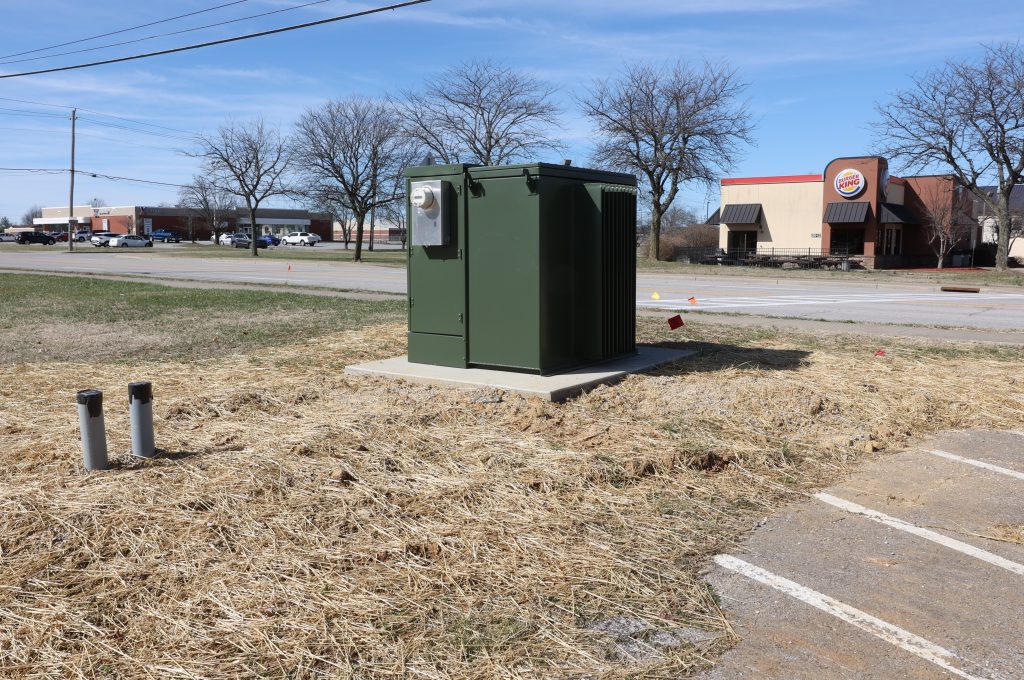
GOING ELECTRIC: An electric vehicle charging station is located near the Regional Network Enterprise Center on Fort Carson, Colorado. As part of its plan to field an all-electric fleet of non-tactical vehicles by 2035, the Army is installing electric vehicle charging stations. (Photo by Anissa Connell, Fort Carson Public Affairs Office)
Upgrades to energy-efficient technology help build a cleaner, healthier environment.
by Holly DeCarlo-White
Almost every American household recognizes the ENERGY STAR label. It is featured prominently on the majority of new electronic items sold today, from lightbulbs to major appliances. ENERGY STAR has grown to become the national standard for energy efficiency and, according to the U.S. Environmental Protection Agency (EPA), one of the most successful voluntary U.S. government programs in history, with a 90% recognition rate among American families. The EPA launched the ENERGY STAR program in 1992, creating a market for energy efficient products, homes and buildings. The program has led to an increase in the production and adoption of energy-efficient technologies and practices by American consumers and businesses, giving them options that use less energy to get the same job done.
Since the program’s inception more than 30 years ago, the EPA reports that American families and businesses have saved more than $500 billion in energy costs and 5 trillion kilowatt-hours in electricity and have prevented 4 billion metric tons of greenhouse gas emissions from entering the atmosphere.

LOOK FOR THE STAR: The U.S. Environmental Protection Agency expanded the program launching the ENERGY STAR Home Upgrade in 2022 to connect American households at all income levels with resources to plan for a clean energy future through a series of high-impact, efficient electric improvements that an save the average family about $500 per year on utility bills. (Image courtesy of the Environmental Protection Agency)
STAR STANDARDS
Both the Department of Energy (DOE) and the EPA promote energy efficiency, and they work together to avoid redundancies and prevent any extra burden for the manufacturers of energy-efficient products. The DOE establishes minimum energy-efficiency standards for products, which are taken into consideration when developing the robust specifications for ENERGY STAR product certification.
Before associating the label with any product model, manufacturers must submit performance data from an EPA-recognized laboratory to an independent certification body for review, to ensure the product meets ENERGY STAR standards tailored for the category it’s in.
Product performance specifications are regularly updated, which any new ENERGY STAR product is expected to meet before earning certification. Across more than 75 different categories, products that earn the ENERGY STAR label meet strict EPA standards for energy efficiency with consideration to technology improvements, market trends and input from manufacturers and a range of stakeholders.
“Our program relies on comprehensive data reporting on product performance, market trends and stakeholder feedback to develop and revise standards for energy efficiency,” said Leslie Jones, media and public affairs specialist for the EPA’s ENERGY STAR Program. “Choosing products that have earned the ENERGY STAR certification is an easy way for consumers to reduce their energy consumption without having to make a daily conscious effort to adopt different habits.”
Performance levels for products that earn the ENERGY STAR label are established by the EPA after reviewing efficiency performance across the range of models in a product category. Label recognition saves consumers the effort of having to look at individual efficiency ratings. By purchasing products with the little blue label (denoting top performers), customers can feel good about saving energy and money while protecting the environment. The program maintains an online search tool, ENERGY STAR Product Finder, to identify products that have been certified.

ENERGY ENHANCEMENTS: One of two 800-amp breaker boxes installed to power the new electric vehicle charging stations at Fort Knox, Kentucky. To support its plan to field an all-electric fleet of nontactical vehicles, the Army is investing in electric vehicle charging infrastructure. (Photo by Jenn DeHaan, Fort Knox)
CLEARING THE AIR
Under the Clean Air Act, Congress directed the EPA to demonstrate nonregulatory strategies to prevent air pollution, including energy efficiency and switching to cleaner fuel sources. The ENERGY STAR program has been vital to supporting this strategy by designating product options requiring less energy.
“When energy consumption is reduced, fewer fossil fuels are burned to accomplish the same tasks, resulting in fewer greenhouse gas emissions and other air pollutants being released into the atmosphere,” Jones said.
In 2020 alone, the program’s emissions reductions were equivalent to more than 5% of total U.S. greenhouse gas emissions. ENERGY STAR’s 2020 energy savings also led to significant air pollutant reductions, responsible for an estimated $7 billion to $17 billion in public health benefits.
According to the World Health Organization, air pollution is one of the greatest environmental risks to health, and reducing air pollution levels reduces the burden of disease from stroke, heart disease, lung cancer and respiratory diseases, including asthma.
Thanks to the Inflation Reduction Act of 2022, which provides nearly $400 billion to support clean energy and address climate change, there are a number of ENERGY STAR-certified products that qualify for federal income tax credits and other incentives making energy efficiency more accessible and affordable. For example, new federal income tax credits provide discounts of up to 30% of the project cost, up to $3,200, for products such as heat pumps, water heaters, windows and insulation.
In 2024, additional income-based incentives are expected through the Home Energy Rebates Program for participating states and tribes to encourage and better enable the population to make energy-efficient upgrades that will lower energy bills and consumption.

AN ECO-FRIENDLY HOME: The new Lower Stilwell housing development at the Presidio of Monterey, California, features ENERGY STAR appliances, LED lighting and water-efficient fixtures. Army offices and installations are working to meet the goals of the Army Climate Strategy, and federal agencies are required to procure ENERGY STAR-qualified and Federal Energy Management Program-designated energy- and water-efficient products. (Photo by Winifred Brown, U.S. Army Garrison Presidio of Monterey)
CONCLUSION
ENERGY STAR provides a comprehensive checklist of energy-saving measures that businesses and commercial building owners can implement to reduce their energy usage. Choosing ENERGY STAR certified products, upgrading to efficient light-emitting diode (LED) lighting and adjusting the buildings’ heating and cooling operations are some examples of key areas to focus on.
Army installations and facilities have all transitioned to LED lighting to meet higher energy standards. Additionally, offices like the Assistant Secretary of the Army for Installations, Energy and Environment and the Army’s Office of the Deputy Chief of Staff for Installations (G-9), are working to meet the goals of the Army Climate Strategy, considering future installation planning, guidance and adaptation. For example, in line with the strategy’s goal of fielding an all-electric, nontactical vehicle fleet by 2035, the Army is building and installing electric vehicle charging stations at more than 70 different sites. Federal agencies are required to procure ENERGY STAR-qualified and Federal Energy Management Program-designated energy- and water-efficient products as standard procedures for energy consumption cost savings.
The ENERGY STAR program defines a set of six high-impact, energy-efficiency improvements individual homeowners can make, too. This includes upgrading a home’s heat pump and water heater, installing a smart thermostat and ensuring well-sealed and insulated windows and attic spaces. Implementing upgrades to energy-efficient technology in the home or business helps transition from fossil fuels to not only save on cost, but also build a cleaner, healthier environment for all.
For more information, go to https://www.energystar.gov.
HOLLY DECARLO-WHITE provides contract support to the U.S. Army Acquisition Support Center at Fort Belvoir, Virginia, as a writer and editor for Army AL&T magazine for SAIC. Previously, she was a public affairs specialist at U.S. Army Garrison Stuttgart, Germany. She holds a B.S. in merchandising management from the Fashion Institute of Technology, State University of New York and has more than a decade of communications and operations experience in the private sector.







